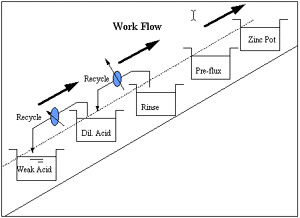C2764
- Galvanising Services Ltd - Auckland Region
Summary
Galvanising Services has virtually eliminated the liquid effluent
discharged to trade waste by implementing a Cleaner Production
programme. The mechanical cleaning process has reduced acid
consumption by 50%. Annual savings from projects implemented
to date are approximately $40,000 with a maximum payback period
of 1.5 years.
Business Profile
Galvanising Services galvanises steel products and nail components
to provide an anti-corrosive layer. The main processes are
metal cleaning and hot dip galvanising. The business employs
20 staff.
Type of Project
Self-regulating flow valves, recycling and filtration of rinse
water from cleaning baths, replacement of caustic cleaning
and acid pickling by mechanical rumbling, continuous preflux
filtration, use of inhibitors, fume suppressants and surface
wetting agents, removal and recycling of zinc dross and dust,
temperature control and insulation of prefluxing bath, negotiating
reduced power rates for bulk power consumption.
Reasons for Project
The company participated in the cleaner production project
due to its social responsibility towards the environment and
also to comply with trade waste regulations.
The Project
| Details |
Negotiating reduced
power rates for bulk power consumption Details Galvanising
Services replaced the power meters from two separate production
units by one power meter. This enabled the business to
negotiate lower power tariffs due to bulk consumption.
The business also took advantage of discount rates for
nights and weekends. |
| Economics |
The total investment for upgrading
the power distribution system was $3,400. Savings from
reduced energy consumption are $4,320 per year. The payback
period is approximately 10 months. |
| Benefits |
Reduced energy costs. Improved
power distribution system. |
METAL CLEANING PROCESSES
Self regulating flow valves
| Details |
The objective
of rinse water conservation is to use only as much water
as is needed. Self regulating flow controls valves have
been installed in the rinse tanks water inlet. The valves
set the water flow at a constant rate (0.06 L/sec) independent
of the back pressure in the mains. The flow control valves
are low cost, easy to install and maintain, and reliable.
The company saves 2000 m3 of water per year. |
| Economics |
Annual water costs are reduced
by $1,700. |
| Benefits |
Reduced water consumption
and costs. |
Recycling and filtration of rinse water from cleaning
baths
| Details |
Wastewater from rinsing tanks needs to be treated to
remove zinc prior to discharge into the sewer. Galvanising
Services previously treated the wastewater with caustic
soda in a neutralisation tank. As a result the zinc
hydroxides precipitated and the clean liquid was discharged
as trade waste. As there was little control over the
neutralisation reaction, however, suspended salts were
discharged with the wastewater.
In the new situation, spent diluted acid and rinse
water are recycled as shown in the figure below. Spent
weak acid is disposed of through a waste contractor.
The spent dilute acid is filtered and then reused in
the weak acid tank. Fresh acid is added to obtain the
correct concentration. Fresh dilute acid is made using
concentrated acid and filtered rinse water. Thus spent
dilute acid and rinse water are recycled rather than
dicharged as trade waste. The suspended iron particles
are trapped in the filter. Water consumption has reduced
by approximately 3,500 L per month. Quantities of wastewater
and sludge discharged and associated cost were reduced.
As the zinc levels in trade waste are reduced, the business
now complies with trade waste bylaws.

|
| Economics |
Reduced water costs
of $2,400 per year. |
| Benefits |
Reduced water consumption.
Compliance with environmental regulations through reduced
zinc levels in wastewater. Reduced wastewater quantities
and costs. Reduced quantities of sludge. |
Replacement of acid cleaning by mechanical rumbling
| Details |
In the nail galvanising
plant at Galvanising Services, the acid cleaning process
has been replaced with abrasive cleaning by mechanical
rumbling. Nails and sawdust are mixed in a rumbling barrel.
The barrel rotation exposes the surface of the nails to
the sawdust which absorbs the drawing soaps and the manufacturing
oils. The impact of nail on nail removes any corrosion
and the activation of the extractor removes both the contaminated
sawdust and any corrosion dust. The process gives reliable
surface finish so there is no need for pickling with hydrochloric
acid, and the component can be directly processed in the
prefluxing tank and the galvanising zinc pot. As a result
consumption of 42,000 l/year of hydrochloric acid is eliminated. |
| Economics |
Capital costs for the purchase
and installation of the system are $45,000. The operating
costs of the mechanical rumbler are nominal. Total estimated
savings from elimination of the acid pickle and rinsing
process are $30,000 and include: - reduced acid consumption
$20,000/year; - reduced spent acid disposal $8,000/year;
- reduced treatment $2,000/year. The payback period is
18 months. |
| Benefits |
Reduced costs for acid consumption,
disposal and treatment. Reduced water consumption and
costs. Reduction of zinc ash and drost generation. Compliance
with environmental legislation. Improved health and safety
conditions resulting in improved staff morale. |
Removal and recycling of zinc dross and dust
| Details |
Details Zinc dross
is a pasty solid comprising of 96% zinc and 4% iron and
is produced by dragout form iron-containing pickle salts,
the fluxin solution, products that are being galvanised,
and iron and steel products reacting with molten zinc.
Zinc ash is a mixture of zinc oxide and entrained zinc,
which is often in excess of 80% of the total weight. Zinc
ash is produced when zinc is in contact with air. Galvanising
Services has reduced the formation of zinc dross and zinc
ash by 18 tonnes per year by: improving work practices
through good housekeeping; filtration of the fluxing solution;
replacing acid pickling by mechanical rumbling (see previous
case study). |
| Economics |
Savings of reduced zinc dross
and ash formation is $45,000 per year. |
| Benefits |
Reduced zinc costs. Reduced
zinc dross and zinc ash waste. Reduced emissions. Improved
health and safety conditions for staff. |
Continuous preflux filtration
| Details |
Details Iron levels
in the zinc ammonium chloride preflux tank must be maintained
at minimum levels of 1% as excess iron has a detrimental
effect on the amount of waste produced. The majority of
the iron is introduced to the preflux through dragout
from the acid tanks. Because of the high iron content
during pickling, rinsing is necessary before prefluxing.
A continuous preflux filtration system has therefore been
installed over the preflux to remove iron from the process. |
| Economics |
As the preflux filtration
system was already available only installation costs were
made. Zinc ammonium chloride savings have not been determined. |
| Benefits |
Reduced zinc ammonium chloride
consumption. |
METAL FINISHING PROCESSES
Use of inhibitors and fume suppressants
| Details |
Details Hydrogen chloride (HCl) is used to pickle clean
steel (Fe) objects prior to galvanising and to strip
old layers of zinc (Zn) from already galvanised objects.
When hydrogen chloride is in contact with steel or steel
oxides, it reacts as follows: Fe+ 2 HCl FeCl2 + H2(g)
FeO + 2 HCl FeCl2 + H2O
Fe2O3 + 6 HCl 2 FeCl3 + 3 H2O
Fe3O4 + 8 HCl 2 FeCl3 + FeCl2 + 4H2O
Similar reactions take place between hydrogen chloride
and zinc:
Zn + 2 HCl ZnCl2 + H2(g) ZnO + 2 HCl ZnCl2 + H2O
These reactions cause three problems for metal cleaning
businesses: the reactions with steel and zinc generate
iron chloride and zinc chloride which end up in the
wastewater stream; hydrogen chloride emissions are produced
near the bath surface through contact with the air.
The vapours are a health hazard for production staff;
during the reactions hydrogen gas (H2) is formed which
is trapped in the solution. The gas is potentially explosive.
Galvanising Services has added inhibitors, fume suppressants
and wetting agents to the pickling baths to solve these
problems:
inhibitors (steel pickling bath): the first reaction
between hydrogen chloride and steel is suppressed by
up to 94-98%. This reduces the formation of hydrogen
gas and the production of iron chlorides;
fume suppressants (both baths): these chemicals
form a "foam" layer on the bath surface, preventing
the emission of hydrogen chloride vapours;
wetting agents (both baths): these chemicals
improve the contact between workpieces and chemicals
in the bath. As a result the pickling process is improved.
|
| Economics |
Economics $600 is spent each
year on inhibitors. This is a slight increase in costs
but this is outweighed by the benefits. |
| Benefits |
Reduced metal corrosion. Reduced
hydrogen chloride emissions. Improved health and safety
conditions for staff and compliance with health and safety
regulations. Improved wastewater quality and reduced trade
waste costs. |
For additional information contact:
Mr A. Lonsdale Cooper,
Galvanising Services Ltd,
PO Box 13181,
Onehunga,
Auckland
Ph 09-6366003
Fax 09-6365967
For further information about Cleaner Production in the
Metal Industry see:
Opus International Consultants (September 1997): Cleaner
Production Guide for the Metal Industry- Minimising waste,
reducing costs and caring for the environment.
|
